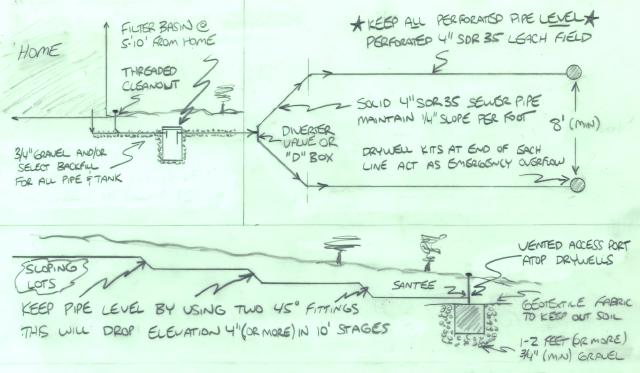Greywater recycling systems reuse wastewater for ornamental plant irrigation
Greywater from your home can be piped directly to a buried vault (settling tank) where solid debris settles to the bottom and grease floats to the top. As greywater flows in, clarified liquid flows out. Greywater systems can be very simple and non-electric when the top of your planterbed (leach field) is below the elevation of the home's effluent pipe. When used as the settling tank of your greywater system, this basin also acts as a grease trap. Install strainer basket screens in all your sinks and use liquid soaps. The more you prevent particulates from entering the settling basin, the less you will ever have to remove. While there are 'grease traps' available for kitchen sinks, we doubt you need to go to that extent with proper precautions. Wipe your plates clean before washing with liquid soaps and you will do fine.
Always limit the amount of debris and sediment going down your drains by installing strainer baskets in every sink, tub and shower. Modern washing machines often do not include a lint filter, so check to see if one can be added. When your utility room sink is installed alongside the washing machine, you can attach a five gallon paint strainer bag to the washing machine effluent hose with a clamp. Laundry lint (synthetic fibers, especially), hair, and sediment (dirt) do not decompose readily, eventually clogging any leach field by creating an impenetrable 'bio-mat', unless filtered out with a settling tank.
Sterilizing greywater on-site to the point where it can be reused for above-ground yard sprinklers or flushing a toilet is never cost-effective. Should your county require sterilization of greywater effluent to meet local building codes, an economical option may be to add an in-line "automatic chemical feeder" for chlorine cakes. Building department (or your engineer) is responsible for helping you find the correct part, but can be the same as used for chlorinating swimming pools. National Sanitation Foundation NSF/ANSI standard 350 and 350-1 onsite graywater reuse systems exist, but they are complex and expensive with way too many electrical components, moving parts, replacement filters, and fixtures that will eventually fail and have to be repaired. Then good luck finding replacement parts. Roof run-off cisterns are an excellent source of toilet flushing water, but recycling greywater to flush your toilet is simply not cost-effective. It is much easier, less expensive, and worlds safer to directly dispose of greywater in a leaching pit or irrigation field. High-tech pressurized systems for drip irrigation are nothing but trouble since drip emitters are prone to clog with calcium deposits very quickly.
do-it-yourself greywater design tips and rules of thumb
* Always install a settling basin with filter in-line before leach field or drain pit
* Greywater tank up to 10 feet away and leach fields 20+ feet from foundation
* Avoid exposing greywater tank lids - best to cover with soil, pavers, or mulch
* Always install a cleanout in sewer line near home foundation for servicing
* Slope four inch pipe 1/8 to 1/4 inch per foot, never any steeper before tank
* Bed all pipe and tank in at least six inches of gravel to prevent frost issues
* Never drain directly atop bare ground or spray greywater with yard sprinklers
* When reusing graywater for plants, add nitrogen since that nutrient is missing
* Never use 'septic treatments' as they do more harm than good to leach field
* Use liquid soaps and avoid harsh detergents, bleach, disinfectants & cleaners
* Never install geotextile fabric on the bottom of leach pit or drainage trench
While possible for a greywater system to not have a settling filter basin tank and just install a perforated pipe leach field, longevity is always compromised. Grease traps under sinks, filter on the washing machine discharge, and screens in all sinks will help reduce sediment and fats, but not eliminate the need for a settling tank that can be pumped. Your county health department dictates local rules and building regulations, but generally, one must always have a settling filter basin to catch solids and fats. Should local code not apply to your project, it is still very wise practice to prevent particulates from entering the leach field, forming bio-mat, and eventually clogging soil and stopping percolation. Always check with your building department to confirm local regulations prior to planning any septic (greywater) system to confirm what is required for your property. The Natural Home is not an engineering firm; we do not provide any engineering services, soil testing or on-site work.
With moving water, especially greywater with some warmth and biological activity, you don't have to worry about freezing issues with proper installation. Key is a well-bedded tank in plenty of +/- 3/4 inch gravel. In cold climates, install at least one foot of gravel under and around the settling tank to prevent sodden, frozen soil (frost) from touching the tank sides. In extremely cold climates, the settling basin lid and surrounding area can be covered with tarp and 2 inch foamboard insulation and then buried at least one foot under finish grade. While possible to install riser extensions to bury the settling basin deeper, it is not necessary or beneficial to bring the basin lid all the way to the surface. One foot soil coverage for the tank lid is typical. Even in the warmest climates, you should at least cover the lid with mulch to protect plastic from UV sunlight damage and make it easier to uncover when checking tank and filter yearly.
Drywells are excellent for use with greywater reuse systems. Sometimes you must divert greywater away from your orchard or planterbed for simple disposal. Fruit trees, for instance, benefit from having their root systems go dry for a few days. Sloped lots are another challenge since the perforated pipe must be installed perfectly level to ensure even distribution of the greywater. As the drawing below illustrates, you can use 45 degree fittings to drop the elevation of your perforated pipe in stages. This is a very simple and effective way to alleviate sloping lot issues. Note the use of drywell kits at the end of each lateral (perforated pipe line) to catch overflow in cases of extreme usage above average day-to-day greywater production. Drywell system cut sheet with gravel installation details for engineers.
Greywater recycling indoor planterbeds or outdoor graywater filtering planter irrigation systems can be very simple and non-electric when the top of your planterbed (leach field) is below the elevation of the home's sewer effluent pipe. Our standard greywater kits include a settling tank (filter basin acting as a grease and debris trap) that sends filtered greywater directly out to the leach field (planterbed). If your planterbed or leach field is uphill from the settling tank location, an electric pump lift station (sump pump) will need to be added to your system. An example sump basin is shown at the end of this page, but your actual pump and tank will vary with lift and head (height and distance) from settling tank to leach field. Greywater recycling operates on the same principles as a septic tank system, except with little or no solid waste, a graywater irrigation system can have a much smaller tank and considerably less leach field area. Building regulations vary from town to town, but some rules-of-thumb for system sizing are:
* settling "septic" tanks for greywater should be at least 50 gallons minimum
* too large of a settling tank and the water does not refresh on a daily basis
* leach field (planterbed) should be 1 gallon per square foot per day minimum
* greywater usage should be estimated at least 50 gallons per person per day
* four people should therefore plan for at least a 200 square foot leach field
* usage of up to 200 gallons per person per day is possible, so do a study
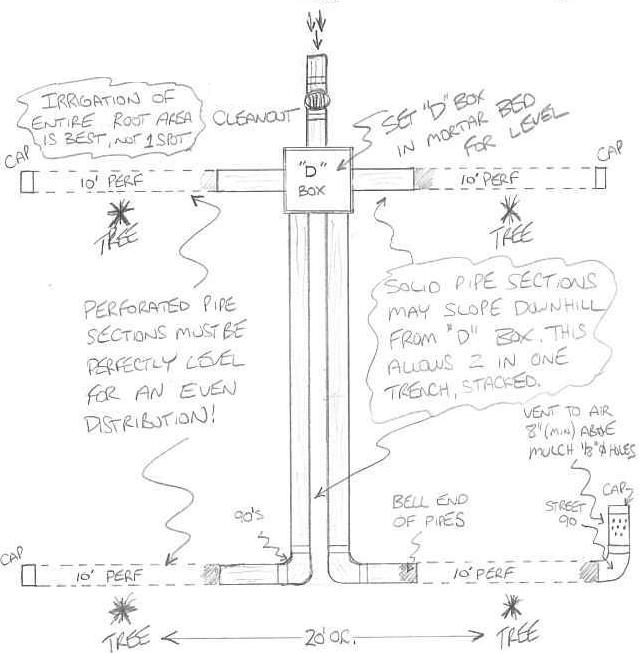
An orchard or row of privacy bushes are perfect uses for household greywater with a single fruit tree easily uptaking fifteen plus gallons per day. A small leach bed system with forty feet of perforated pipe can easily dispose and reuse well over 120 gallons of greywater per day. These first two drawings outline a conventional septic system type leach field (pipe-in gravel buried one foot minimum). One thing to note is that root infiltration will eventually become a problem with any conventionally buried pipe-in-gravel systems. The filter fabric specified here certainly helps avoid such root infiltration problems, but nature has a way of getting around even the best geotextile fabrics. Depending upon local codes, you may be limited to this type of system, but there is an excellent option. The third drawing outlines a more effective shallow burial of perforated pipe (under a mulch layer) to avoid root infiltration. As always, check with local building and/or health department officials before installing any greywater system.
The following type of leach field is much most effective for greywater irrigation. By laying the perforated pipe atop the tilled 'scarified' soil, you avoid any problems with root infiltration. A thick layer of mulch ensures that the pipes are not affected by sunlight and prevents freeze problems in the winter. In extreme climates, increase the amount of mulch in winter months. The sketch below leach field detail drawing shows a much larger layout for disposing of hundreds of gallons per day. It is important to design the layout size to match the soil percolation properties and amount of greywater being disposed of daily. Installing at least one drywell kit in leach pit allows seasonal flow to be diverted. For instance, redirecting graywater during the winter months to allow trees to go dormant and avoid root freezing issues with other landscaping plants.
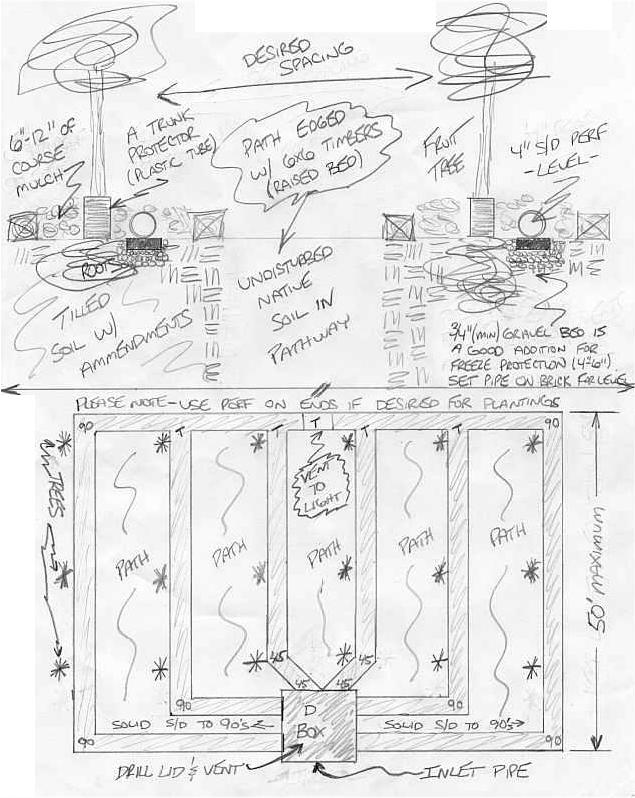
Here's a greywater leach field built as a planterbed atop the existing ground on a sloped lot. This makes for a unique focal point in any yard. As a matter of personal safety, do not use pressure treated lumber around food crops and fruit trees. Be sure to scarify the existing soil under your planterbed well — till and or turn the soil with machinery to ensure good percolation.
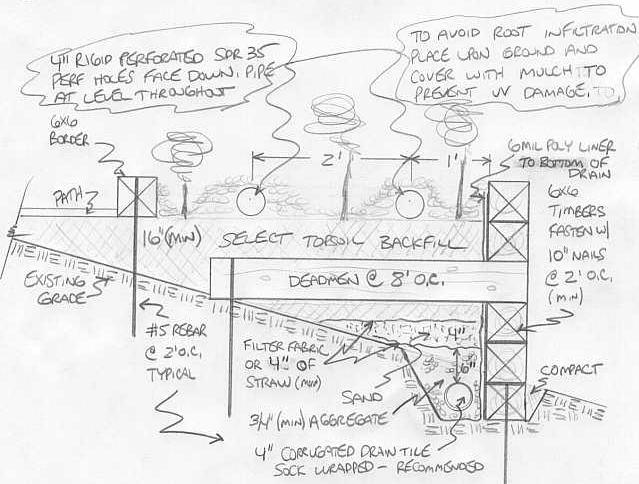
need a sump pump lift-station for the system too?
If your leach field or planterbed is uphill from the settling tank (filter basin), you will need a sump basin (tank with automatic pump) in-line directly after filter basin. When burying the sump basin (lift station) outside your home, it is always best to install one of the settling basins shown above. When you are able to plumb the lift station (sump basin) inside the home, you can use a sump basin kit. Shown at right are two common sizes of sump basin kit with the pump at middle front in picture. We do not advertise sump pump and sump basin kit pricing on this website since they are truly best purchased locally. Plus, pumps must be sized correctly for the system and site needs, so they are something best left for last in any greywater system design.
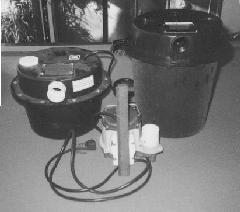
Last updated on February 6th, 2024

